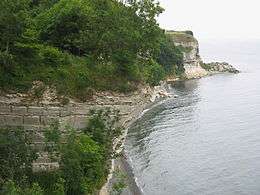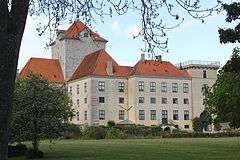Stevns Municipality
| Stevns Municipality Stevns Kommune | ||
|---|---|---|
| Municipality | ||
| ||
|
| ||
| Country | Denmark | |
| Region | Region Zealand | |
| Seat | Store Heddinge | |
| Government | ||
| • Mayor | Mogens Haugaard Nielsen (V) | |
| Area | ||
| • Total | 249.92 km2 (96.49 sq mi) | |
| Population (1 July 2014) | ||
| • Total | 21,920 | |
| • Density | 88/km2 (230/sq mi) | |
| Time zone | CET (UTC+1) | |
| • Summer (DST) | CEST (UTC+2) | |
| Municipal code | 336 | |
| Website | www.stevns.dk | |
Stevns is a municipality (Danish, kommune) in Region Sjælland on the southeast coast of the island of Zealand (Sjælland) in south Denmark. The municipality covers an area of 250 square kilometres (97 sq mi), and has a population of 21,920 (1 July 2014). From 1 January 2014, its mayor is Mogens Haugaard Nielsen. He is a member of the Venstre (Liberal Party) political party. The 1st deputy mayor is Varly Jensen. He is from the Danish People's Party. The 2nd deputy mayor is Steen S. Hansen. He is from the Social Democrats. The 19-member municipal council was elected 19 November 2013 for the four-year term 2014-17. The municipality covers most of Stevns Peninsula.
The third largest town and the site of its municipal council is the town of Hårlev.
On January 1, 2007 Stevns municipality, as the result of Kommunalreformen ("The Municipal Reform" of 2007), merged with Vallø municipality to form an enlarged Stevns municipality.
Urban areas
The ten largest urban areas in the municipality are:
| # | Locality | Population |
|---|---|---|
| 1 | Strøby Egede | 3,907 |
| 2 | Store Heddinge | 3,327 |
| 3 | Hårlev | 2.516 |
| 4 | Rødvig | 1.643 |
| 5 | Valløby | 756 |
| 6 | Strøby | 669 |
| 7 | Hellested | 613 |
| 8 | Klippinge | 517 |
| 9 | Magleby | 322 |
| 10 | Lyderslev | 317 |
The town of Store Heddinge
The town of Store Heddinge came into existence during the 13th century, and Saint Katharina Church (Sct. Katharina kirke) is also from that time. The town received privileged status as a merchant town in 1441. A Latin preparatory school was founded in the town in 1620, but was closed down in 1739.
Attractions

The area is known for its white chalk cliffs, which are quite rare in Denmark. Stevns Klint (Stevns' Cliffs), a popular tourist attraction, is one of these. The old town church by the small village of Højerup collapsed partially over the cliffs in 1928 due to erosion.
The cliffs at Højerup are also the place where the father-and-son team of scientists Luis and Walter Alvarez measured[1] the highest level of iridium in the Cretaceous–Paleogene boundary layer, which led them to propose their hypothesis that the Cretaceous–Paleogene extinction event was caused by an impact of a large asteroid 66 million years ago.
In 2008 the Cold War Museum Stevns Fortress opened to the public. It features a large exhibition of military equipment and a 1.5-hour guided tour in the large underground system of the fortress. The underground system of the fortress features 1.6 kilometres (0.99 mi) of tunnels, living quarters, command centers, hospital and even a chapel. And in addition two ammunition depots for its two 15 centimetres (5.9 in) cannons. The tunnels are 18–20 metres (59–66 ft) below surface excavated in the chalk of Stevns. This top secret fortress was built in 1953 and remained operational until 2000.
Stevns is also home to Elverhøj (Elves' Hill), while not much of an attraction, it is famous for the fairy tale The Elf Mound by H.C. Andersen and the Danish national play Elves' Hill, both of which in Danish share the name Elverhøj.
Image gallery
 St. Catherine's Church, Store Heddinge
St. Catherine's Church, Store Heddinge Gjorslev Castle
Gjorslev Castle
References
- ↑ Alvarez, Luis W.; Alvarez, Walter; Asaro, Frank; Michel, Helen V. (June 6, 1980). "Extraterrestrial cause for the Cretaceous–Tertiary extinction". Science. 208 (4448): 1095–1108. CiteSeerX 10.1.1.126.8496
 . doi:10.1126/science.208.4448.1095. PMID 17783054.
. doi:10.1126/science.208.4448.1095. PMID 17783054.
- Municipal statistics: NetBorger Kommunefakta, delivered from KMD aka Kommunedata (Municipal Data)
- Municipal mergers and neighbors: Eniro new municipalities map
External links
| Wikimedia Commons has media related to Stevns Kommune. |
Coordinates: 55°20′N 12°19′E / 55.333°N 12.317°E

